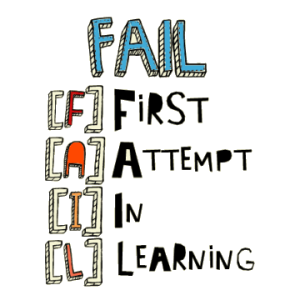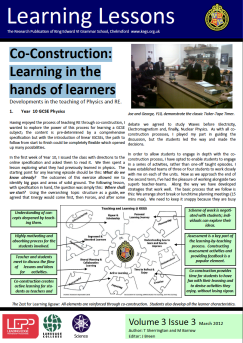Co-constructing lessons is a movement towards giving students ownership of their learning
Last week I delivered a session for NASSSA and 3P Learning to support South Australia in their ground-breaking work on increasing the engagement of learners. We were focussing on Science through Three Act Science and also on co-construction – using the students as stakeholders in devising activities in the classroom. This can be contentious, with some teachers arguing that students dont have the in depth understanding of pedagogy to be able to separate education from entertainment. Others arguing that we have a duty to include students in the process.
Rather than seeing the student as a consumer ( and how many of our students see education as something that is done to them? ) we could view them as a stakeholder, a central part of the process. Consumers are often forgotten about as soon as a transaction is complete, but stakeholders continue to take an interest and everyone benefits in the short and particularly the long term. Co-constructing lessons is a powerful step in developing the student as a stakeholder.
South Australia are as far as I know the only education authority to put this model at the very heart of its education philosophy. They have produced a Leading Learning resources here which is an extremely comprehensive and impressive collection that support the whole student centred ethos
An animation showing the ideas is here
Professor Martin Westwell from Flinders University explains the intent of the program
Training
The first day I delivered training at the genuinely revolutionary Australian Science and Mathematics School attached to Flinders University – Website here . This to me is what education should look like. Open plan areas, team teaching and self regulating motivated learners. I was reminded of the Liverpool Life Sciences UTC here with a very similar open and challenging ethos. The enthusiastic and knowledgeable teachers there made me feel that the future of South Australian education is in good hands. Thank you to them for making me so welcome and engaging so well in the activities.
If anyone is interested in the behaviour aspects I talked about there is a blog here outlining my ‘beyond compliance’ approach
For the essence of motivation see the RSA animate by Dan Pink below
The second day I led was one of teachers and students sitting together and working on the ideas to find a way of delivering the curriculum that meets everyones needs. Co-constructing lessons has quite a high time and risk factor. I was slightly concerned at what might happen, would the teachers dominate? would the students rebel and have a go at the teachers?
I needn’t have worried. At the start of the day some of the teachers were simply directing in the expectations of their roles. I put in some origami and problem solving activities that levelled the playing field (the origami allowed a couple of quiet girls to excel and to assist the teachers and that broke some barriers) as the day went on the teachers moved from dominating to listening and valuing. The first step towards genuine co-construction and partnerships.
Structure of the Day
The day was the middle one of three with the aim of introducing, creating and evaluation across the three days in order to start to embed co-construction.
Fail!!!
I started the day with the idea of what failure means . As far as I am concerned scientists never fail, they simply learn (unless they die or fail to learn )
Growth Mindset is hugely important . See the work of Carol Dweck
The idea of engagement linked to disposition and more is outlined by Dr Chris Goldspink here
A great poster to put in every classroom is this one. Every piece of work should really be seen as a draft
As I was working with science teachers the next phase was to discuss what an outstanding learner in science looks like. Every student I have ever asked has said the same . Gets top marks , answers all the questions, does their homework, well behaved. None of the students I have asked thought they could be outstanding , nor did they particularly want to be one with that definition. I tasked the teachers and students to come up with four points that had to fulfil the criteria that everyone could be that and that it was desirable to be that.
An example of some of the ideas are
- Someone who asks questions
- Is resilient in the face of difficulty
- Creative and prepared to try things out
- Prepared to listen to others and respect their views
Ideally print them out and stick them as posters on the wall
We then went through the elements of thinking using the work of Daniel Kahneman outlined in this blog
and why we are reluctant to think. Learning only takes place when
Questioning was considered with first the teachers and then the students (I gave them the option and they rose to the challenge ) leading a pose pause pounce bounce session outlined by Dylan Wiliam here
and why this is a far more effective technique – turning table tennis a mainly spectator activity into basketball where everyone is involved,with nowhere for students to hide and the teacher able to fully differentiate. The value further increases if socratic questioning is used . This page is taken from the Leading Learning Resource
Socratic Questioning Click the link for the pdf
Divergent Thinking
In their study Break Point and Beyond, Land and Jarman found that divergent thinking – the ability to find creative solutions to problems diminished rapidly as the students aged – Possibly due to us teaching that there is only one real answer? We need to find questions that google cannot answer and that don’t limit creative solutions . So
“How many ways can you think of to make a teabag fly ?”
Give several minutes to do this with teachers and students working together. Older people tend to suffer fixation – when we have a solution in our minds we struggle to see others. Remember when you have a word to answer a crossword puzzle that doesn’t quite fit, how hard is it to get that word out of your head?
Younger students dont have this fixation problem and we need to find ways to keep them practicing
Then we turned the attention to Three Act Science – outlined in several posts I have written here and looking at hooks and how we can turn them into rich learning experiences in Act 2
The Prezi I used on both days is here
The 3 act approach ties in with the Leading Learning Bringing it to Life – BitL Tool you can find here or download it from the App store here
A very impressive and groundbreaking tool is the Science Misconception Tool available at the bottom of this page here
Activities throughout the day involved looking at creating solar stills from paper and plastic bags to collect water, This can be found in my Teaching Heat Transfer blog here
We fired fruit and vegetables in a wild sling having predicted which would go furthest – predictions are needed – see Confusion vs Clarity blog here
Wrapping up – Was a very enjoyable and productive day. Co-constructing is not a simple thing to implement – there are a lot of barriers but certainly from what I saw in South Australia there is a real possibility of change toward
Some other research
Professor David Hargreaves writing in A New Shape for Schooling articulated a description of the learner who would be the ideal outcome of personalisation, that is, in a school where personalising learning is embedded.
The learner when personalisation is well developed: an articulate, autonomous but collaborative learner, with high meta-cognitive control and the generic skills of learning, gained through engaging educational experiences with enriched opportunities and challenges, and supported by various people, materials and ICT linked to general well-being but crucially focussed on learning, in schools whose culture and structures sustain the continuous co-construction of education through shared leadership.
The educator when personalisation is well developed: A person who is passionate about learning, for self and for students, a skilled mentor and coach, committed to the co-construction of all aspects of schooling; who views students as partners in the creation of, and access to, data about their learning and achievement to assist in their progression; who is an expert in a relevant domain but who knows that forging the conditions of successful learning is not simply a matter of telling; who strives to engage students to generate the motivation that underpins true learning; who recognises that student needs are complex and variable and so personalisation entails drawing on a wide range of human and material resources to support learning; and who constantly relishes the changing responsibilities of a leader in education and of the need to redesign our educational institutions.
Taken together, these person specifications constitute a transformation of education and a transition from the 19th century model of schooling to one that is fit for purpose in the 21st century, with its need for a different kind of person, educated in a different kind of schooling, for a different kind of society.
Read the full document here and Tom Sherringtons post Co-constructing your classes: Putting pupils in the driving seat is here
There are also a couple of articles in the Learning Lessons below
Other research
The experiences of Boston and Sacramento also suggest that meaningful, districtwide student engagement in school policies and initiatives requires a true partnership between a diverse group of young people–some of whom may be unsure about how to find their voice in the adult-dominated world of schools–and the adults who sit on school boards and traditionally create district policies. These case studies demonstrate that, with the appropriate amount of support and training, these young people, regardless of where they begin, will be able to step up, take action, and represent their peers by voicing their opinions and advocating for change.
Full report here







